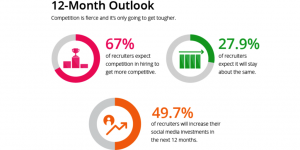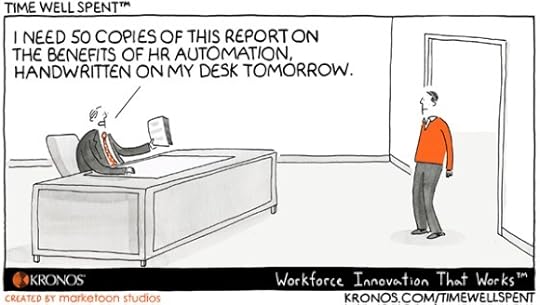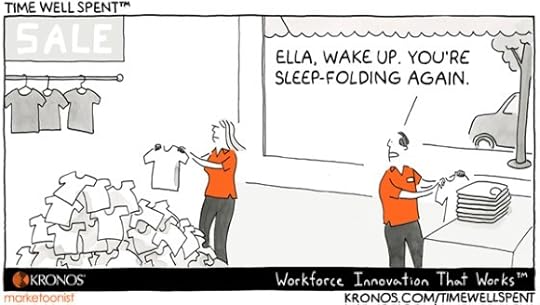Sharlyn J. Lauby's Blog, page 155
June 26, 2016
Employment Branding Is Dead
Sorry – I couldn’t resist the dramatic title for today’s post. But it’s true. Employment branding as we know it is gone. So is consumer branding. They are being merged together to create one company brand. A brand that will be used to attract and retain customers, candidates, and employees.
Some might argue that their organization already has one brand. But under that one brand, the organization creates specific marketing materials to attract customers. And specific collateral to attract candidates. Also, some organizations create marketing stuff for employees like t-shirts, etc. It promotes the company and instills pride.
One of my big takeaways from this year’s Great Place to Work conference was the move away from that type of one brand with three different types of marketing collateral. Organizations are creating a single brand and integrating all of their messaging into their marketing collateral. A terrific example is this video from GoDaddy.
If I’m a customer, I know exactly how GoDaddy is going to support me and my business. If I’m a candidate, I understand the GoDaddy culture – the everyday hard work that’s expected to keep customers’ business dreams alive. And if I’m an employee, I’m proud to be a part of that success. One brand. One video. For multiple audiences.
To help build this winning message, I saw human resources and marketing attendees from the same organizations attending sessions and comparing notes during the conference. There was a tremendous amount of cross functional collaboration on how organizations should convey one brand. Not “here’s what we can do for customers” and “here’s what we can do for candidates.”
We’ve talked in the past about how human resources needs to adopt a marketing mindset. It was exciting to talk with some marketing professionals who were trying to adopt the HR mindset. Think of the possibilities when it comes to resource sharing and communication.
It’s going to be a challenge to blend messaging, but I believe it can be done. When it works, it will elevate the entire organization. Because, like in the GoDaddy video, everyone sees how they fit. That’s what engagement is all about – engaging customers, candidates, and employees.
GoDaddy video used with permission
The post Employment Branding Is Dead appeared first on hr bartender.






June 24, 2016
A Social Media Presence Is Not Optional [infographic] – Friday Distraction
I ran across an article on the Society for Human Resource Management (SHRM) website recently titled, “Job Seekers Need to be on Social Media.” But what struck me about the piece was the subtitle, “It’s practically mandatory for job seekers to have a presence online.”
Part of me wonders if this is old news. Don’t most business professionals today understand that having an online presence is essential? Even if it’s only on LinkedIn – which does count has having an online presence. So much of our lives is being moved to the web that it’s important for any business pro – not just a job seeker – to manage their online brand well.
In case you’re looking for some tips to focus on, check out today’s infographic courtesy of Jobvite. It talks about recruiting priorities but has a lot of interesting data about how a person’s social media presence is interpreted.
Good grammar still wins (and probably always will.) I was surprised that political affiliations received such high marks for being neutral – I’ve seen some real mudslinging political commentary over the years. I was also happy to see volunteerism continues to be a positive.
Now I did notice that the Jobvite infographic had quite a large neutral rating for limited or no social media presence. On the surface, that might be seen as contradicting the SHRM findings. But notice that the second highest response is negative. It makes me wonder if we’re seeing a trend and more organizations will expect to see a social media presence in the years to come.
From a business perspective, there is no doubt – social media is not a fad. Organizations are using it. And if we’re not there already, it’s only a matter of time before it’s expected.
The post A Social Media Presence Is Not Optional [infographic] – Friday Distraction appeared first on hr bartender.






June 23, 2016
Does Changing Company Culture Mean You Must Change Leadership
A couple of months ago, I wrote a post about how individuals can change company culture. I later received a note on Twitter with a great question:
A change in company culture = A change in leadership. You can’t change the leopard’s spots right?!
At first glance, I would say “yes.” We often talk about how senior management sets the tone of the organization. And when it comes to implementing policies, procedures, etc. within the organization, we absolutely need the buy-in of senior management to be successful.
But then I remembered the Kronos study that addressed “Who Owns Your Company Culture?” In the report, forty percent (40%) of Millennials said that employees define culture. In addition, thirty-three percent (33%) of human resources professionals thought they defined culture. And twenty-eight percent (28%) of employees said no one defines culture.
So does changing senior management create a change in culture. Yes. But changes in key employees could also have a significant change in culture. Maybe it’s not a person’s job title that determines an impact on company culture. Instead, maybe it’s a person’s level of engagement. For example, I’d like to think a very engaged line employee is proud of their work and the contribution they make to the company. They probably have excellent working relationships with their manager and team. If that highly engaged employee leaves, it has an impact.
On the other hand, let’s say you have a disengaged manager. They come into work, hide in their office, and do the minimum to stay off the radar. The employees are an interruption to this manager. If that manager leaves, it will have an impact. Probably a positive impact. But nonetheless, an impact.
Those are the easy examples. The tough example is something like this. When we talk about changing company culture, we’re not always talking about going from a “bad” culture to a “good” one. Sometimes companies need to change their culture because of business model changes or pressure from external factors. It could be that the culture needs to go from “good” to “great.” Or from “Great 1.0” to “Great 2.0.”
In those situations, everyone needs to embrace a little change. It’s possible that a small group might have to be the early adopters in the hopes everyone else will eventually get on board. It’s also very possible that the small group might be senior management. Alas, we get back to senior management again. But I do think it’s a bit different. Yes, senior management is playing an early role. But are they having a lasting effect? If employees don’t get on board with the change, then senior management wasn’t successful.
As organizations become more collaborative and transparent, more and more individuals will impact company culture. While some might have an early impact, others will have a longer-lasting impact. Job titles don’t drive company culture. Individual skills, abilities and engagement do.
Image taken by Sharlyn Lauby after presenting to HR leaders in Reykjavík, Iceland
The post Does Changing Company Culture Mean You Must Change Leadership appeared first on hr bartender.






June 21, 2016
Asking Your Boss to Telecommute – Ask #HR Bartender
The harder it is to find qualified employees, the more we pay attention to retaining talent. Companies don’t want employees to leave, because they can’t find a replacement. Or they can’t find a replacement quickly. So one of the ways to keep employees is to give them a benefit – like working from home.
But for telecommuting to be successful, everyone must be on the same page. That’s what today’s reader note is all about.
My husband is being put on a project in India for three months for work (we currently live in California) and his employer is taking care of our Visas. We feel that three months is too long to live apart so I planned to go with him and my boss enthusiastically agreed that I could telecommute during that time so that I won’t interrupt my job, which lends itself well to working remotely.
However, when my boss brought it up with HR, they told him it would not be OK for me to telecommute. We are keeping our home in California and will be gone a very short time, is continuing to work for my employer OK? I’m finding conflicting information online.
There are a couple of issues here – telecommuting and being a trailing spouse – so I’m going to write about them separately. First, the telecommuting part. Basically, telecommuting is when someone works from home. This doesn’t necessarily mean the employee never goes into the office. It’s possible they would be asked to attend meetings or certain events. But the majority of time, they’re working from home.
It also doesn’t mean the employee can do whatever they want. Typically, an organization would have a telecommuting policy that all employees would be expected to follow. Or the company would have an agreement with the employee regarding performance expectations.
I’m not aware of any law that requires organizations to offer telecommuting. But just to be sure, I asked our friend Kate Bischoff, attorney with the firm Zelle LLP in Minneapolis. She confirmed that there’s no affirmative requirement that an employer offer telecommuting as an option. However, she did add that “if an employee can do his/her job over the interwebs, does not need to attend meetings in person, then telecommuting may be a viable option as a reasonable accommodation for an employee’s disability.”
 Kate cited a decision out of the U.S. Sixth Circuit Court of Appeals entitled EEOC v. Ford Motor Co. “In the case, an employee suffered from irritable bowel syndrome (IBS) – a nasty disease. She worked from home on occasion and requested that she could work from home even more. The Equal Employment Opportunity Commission (EEOC) argued that working from home was a reasonable accommodation. Ford obviously did not agree. Ford argued that the company needed her to be at work since her job was ‘highly interactive.’ The EEOC prevailed at the District Court level, but Ford won at the Court of Appeals. While some management-side employment attorneys rejoiced, none of us believe that the issue is settled.”
Kate cited a decision out of the U.S. Sixth Circuit Court of Appeals entitled EEOC v. Ford Motor Co. “In the case, an employee suffered from irritable bowel syndrome (IBS) – a nasty disease. She worked from home on occasion and requested that she could work from home even more. The Equal Employment Opportunity Commission (EEOC) argued that working from home was a reasonable accommodation. Ford obviously did not agree. Ford argued that the company needed her to be at work since her job was ‘highly interactive.’ The EEOC prevailed at the District Court level, but Ford won at the Court of Appeals. While some management-side employment attorneys rejoiced, none of us believe that the issue is settled.”
Organizations would be well served to think about telecommuting from a strategic perspective. Kate shared that she was answering my question about telecommuting from a picnic table at her family’s cabin. “As technology advances, we’re increasingly able to work from anywhere at almost any time. For this reason, I don’t think the request to work from home as a reasonable accommodation is going to go away any time soon. Technology is making this sort of accommodation even easier to do and less of an undue burden for employers to accommodate. Even without the Americans with Disabilities (ADA) reasonable accommodation requirement, more and more employees want the flexibility to work from anywhere. The desires of those employees will force employers to do it to keep talent, so without the law, the talent market may require employers to do it even faster.”
Just because telecommuting is becoming less of a burden for employers and employees, doesn’t mean there aren’t advantages and disadvantages to telecommuting. Here are a few resources worth reading:
Here’s How to Convince Your Boss to Let You Work from Home
5 Benefits of Telecommuting for Employers and Employees
Looking for a Workshifting Occupation
Want to Work Remotely? Here’s How to Ask
7 Considerations for Setting Up a Home Office
There’s also one other thing to consider. In this situation, the reader is talking about three-months. If telecommuting isn’t an option, it might make sense to ask for a sabbatical. I know it eats into the household budget, but it does allow someone to leave for a few months and return. Here’s an interview I did with Take Your Big Trip on “How to Talk with Your Boss about Talking Time Off.”
Last thing, and this is directed at the manager and human resources professional in this story. The key to any successful policy and employee request is being on the same page. The “manager says yes; HR says no” scenario happens way too often. If there isn’t a policy in place, managers need to talk with HR before approving telecommuting. And if the manager thinks telecommuting will work (even if there is no policy), HR might want to think about using this situation as a test case. No one wins when the employee is caught in the middle.
Next week, we’ll tackle part two of this reader note – trailing spouses. Stay tuned!
Image taken by Sharlyn Lauby in a South Florida parking garage
The post Asking Your Boss to Telecommute – Ask #HR Bartender appeared first on hr bartender.






June 19, 2016
How You Can Repair Trust
A big takeaway during this year’s Great Place to Work conference was that transparency builds trust. And that trust is often broken when the organization does things that are contrary to their culture. Because culture tells customers, candidates, and employees what to expect. Great Place to Work CEO Michael C. Bush talked about it in the context of creating a “great place to work for ALL”, not only for a majority.
But every once in a while, stuff happens and trust is broken. We can’t simply ignore it or wish it would fix itself. When trust is compromised, we have to take steps to repair the situation. During one of the conference sessions, a company very bravely shared some of the things they did to repair trust within their organization.
Admit mistakes. I’m sure we both know plenty of organizations that refuse to admit error. They may spin a conversation to make it sound like a mistake was a calculated decision. In today’s business world, authentic and transparent reactions can yield positive outcomes. Make a mistake? Admit it.
Role reversal. I really liked this option. When employees ask “Why does so-and-so always have to do this?” or “Why does the process have to be this way?”, give individuals the opportunity to walk in another person’s shoes. It might help them understand why a decision was made or not made.
Solicit feedback at all levels. We know this, right? When asking for feedback, carefully consider a blend of anonymous and non-anonymous formats. It might take accepting and acting upon some anonymous feedback to rebuild trust to the level where non-anonymous feedback is acceptable and embraced.
Listen and fix the problem. One of the worst things companies can do is ask for feedback and not do anything with it. In fact, when it comes to trust, that could be a major reason for the breakdown. If companies are serious about repairing trust, they need to take action.
Hold people accountable. Speaking of taking action, in my opinion, the most important step a person or company can take to repair trust is holding themselves and their teams accountable for all of the previous steps. Be a person of your word. Take steps that align with the company culture, so the trust breakdown doesn’t happen again.
The naïve part of me wants to believe that people and companies don’t set out to intentionally deceive others. But we know that’s not always true. However, there are times when trust is broken unintentionally. During those moments, we might want to give others the opportunity to regain our trust and build a stronger working relationship.
Image taken by Sharlyn Lauby while attending the Great Place to Work Conference
The post How You Can Repair Trust appeared first on hr bartender.






June 17, 2016
Time to Set Technology Expectations – Friday Distraction
(Editor’s Note: Today’s post is brought to you by our friends at Kronos, the global leader in delivering workforce management solutions in the cloud. Congratulations to Kronos CEO Aron Ain for being awarded . We’ve had the pleasure of speaking with Aron on this blog. Enjoy the post!)
Today’s Time Well Spent from our friends at Kronos really cracks me up. I couldn’t resist sharing.
The sad truth is … this still happens.
I get it. Not everyone wants to read using their tablet. Their preference is to read from paper. They might find that highlighting and jotting notes in the margins works for them. Other people take that pile of paper and immediately toss it in the trash. They want to travel light and having the file on their laptop or tablet makes total sense.
It doesn’t even matter that the cartoon is pointing out the report is on automation. As business professionals, we can easily accommodate everyone by setting expectations.
“Here’s a copy of the report on HR automation we will be discussing tomorrow. In an effort to save paper, hardcopies will not be distributed. Please feel free to bring a copy of the report with you to the meeting.”
This way, the people who want paper will bring paper and the people who want tech will bring their device. Now, this means two things for the meeting organizer:
The report must be distributed in a timely fashion. Participants need time to open the email, review the report, decide if they want to print it, etc. None of this “distributing the report two hours (or two minutes) before the meeting.”
Technology cannot be discouraged in meetings. Participants should be held accountable for their actions. If they are using a device during the meeting, then it should be for an appropriate reason.
Technology is becoming a large part of our professional lives. I’m not anti-paper, in fact, I like paper. But for some things, reading on my iPad is perfectly fine. It can save me time and the nuisance of traveling with lots of papers. Oh, and let’s not forget, it reduces the chance of losing something.
The point is to give people the choice.
The post Time to Set Technology Expectations – Friday Distraction appeared first on hr bartender.






June 16, 2016
Helping Your Organization Heal – #Orlando
I consider Orlando, Florida to be home.
I wasn’t born in Orlando. In fact, many people who call Orlando home weren’t born in The City Beautiful. I went to high school in Orlando. Graduated from college in Orlando. I went to my first gay bar in Orlando. Met Mr. Bartender and got married in Orlando. We bought our first home together in Orlando. Got my first human resources job in Orlando.
You get the point. #IAmOrlando
But a lot of people who don’t have my years of connection to the city are feeling the same sadness, anger, frustration, fear and emotions from the incident that took place over the weekend. They have their own Orlando story and feel a connection. Whether it’s because of a person they know, a trip they took, or something else, it’s deeply personal. It’s possible as you’re reading this, you have your own Orlando connection.
If you’re like me, right now you’re planning and packing for the Society for Human Resource Management (SHRM) Annual Conference. I can’t help but think about past conferences, like SHRM 2014 in Orlando. As human resources professionals, we have a dual role during times of grief. We have to deal with our own personal emotions that we are processing, while helping others within the organization. We have to help people heal while, at the same time, help keep the business running.
This is a time for organizations to use their resources to help employees. There will be people who are visibly upset but, for others, it’s difficult to see their thoughts. We shouldn’t make assumptions about the way others feel and we don’t have to become professional counselors. Here are a few things to consider:
Contact your employee assistance program (EAP) to see what options are available to employees. Some employees might be reluctant to ask if services are available. Proactively letting employees know they can use their benefits could be helpful.
Find out if your health insurance plan offers any benefits employees might be able to use. Employees might have family members who need help. Knowing the answer could help employees maneuver through the complexities of the system.
Offer guidance to managers about the appropriate ways to discuss the topic with employees. Managers might be reluctant to address the issue with employees and feel keeping the conversation “strictly business” is the way to go. Let managers know it’s okay to talk with employees and possibly, cut them a little slack when it comes to distractions and work.
Search the industry resources available for articles, tools, and templates. For example, SHRM has a wealth of resources on disaster preparedness, workplace violence, and dealing with the death of an employee or coworker. SHRM sent me a list of links you might find helpful – I’ve put them together on this downloadable document.
Have resources available to the human resources team. It could make sense to keep a book about grieving at work in the HR library. Here’s one to take a look at: “Healing Grief at Work: 100 Practical Ideas After Your Workplace is Touched by Loss.”
Bring in a counselor to chat with employees to help them heal. Don’t make the assumption that using a counselor is overreacting. These professionals do their job very well and are trained to handle conversations privately without a disruption to the business.
Years ago, I was on the emergency response team for an airline crash. Every person on the plane passed, including employees. Every employee was touched by the experience. It didn’t matter what their role was in the organization or whether they knew the people on the plane. That tragedy changed my life forever. As a HR pro, my takeaway was an understanding that grief and the need to heal impact each of us uniquely and we should never make assumptions about how people should process their emotions. We can offer help and support.
The post Helping Your Organization Heal – #Orlando appeared first on hr bartender.






June 14, 2016
The 10 Habits Great Managers Use to Engage Employees
Managers have a tough job. First, they have knowledge or skill in their area of expertise that the organization relies upon. And, they have a responsibility to engage employees. I would contend that the responsibility to engage extends beyond their direct reports. Managers are asked to set the example and create an engaging work environment with each employee interaction.
What does that look like? Well, many managers are promoted from within. They are high-performing employees who have exceptional technical skills. They also have a few habits when it comes to working with employees that make them stand out.
They know when to help employees and when to let them figure it out. One of the hardest things managers have to learn is not to swoop in and fix everything. Employees need to learn and sometimes learning involves making mistakes. Great managers walk that fine line between teaching employees and letting them learn for themselves.
They are self-aware, knowing their strengths and weaknesses. Great managers know the things they do well and the things they need to improve. They surround themselves with people who complement them…and they’re not afraid to tell people, “I’m looking for someone who can balance my XX skill.”
They are happy and positive. Great managers don’t have to be sugary sweet. But let’s face it, negativity isn’t going to breed employee engagement. Managers know how to focus on the positive and turn adversity into an opportunity.
They seek employee feedback (including about their performance.) One of the best ways to engage employees is by making them a part of the work. Asking their opinions and soliciting feedback. Great managers regularly ask for feedback. And employees know they can freely offer comments and criticism.
They recognize employees the way that the employee wants to be recognized. This is equally true of communication. Great managers know sincere and authentic communication and recognition is personalized for the recipient. They understand that fair and equal are two different things.
They know how to make decisions. This aligns with Habit #4. Great managers get employees involved in decision making. Not only the simple decisions but the messy, complex ones too. They know what decisions employees should make on their own, what decisions they should make for the team, and what decisions should be a collaborative effort.
They are a team player (with their staff and with their peers.) Great managers realize they not only have a team but they are part of one too. Employees are very aware of managers who do not get along with their peer group. It sends up a red flag about their leadership and ability to stick up for their employees.
They know how to manage up. Great managers understand that the key to getting things done is effectively managing up. Please note I didn’t say sucking up. Managing up is the ability to keep senior management informed and educated about work so organizational efforts and resources continue to flow in the right direction.
They provide value by delegating well. This goes with Habit #1. Great managers know the work they should do themselves and the work they should delegate to others. They embrace the idea of employee learning and are very comfortable with employees gaining new skills.
They are comfortable with the words “I don’t know.” Managers don’t need to know everything. Great managers realize this and are fine with researching the answers. They are fine with saying, “I don’t know. Let’s find out.” They’re cool with asking the question.
Here are the 10 habits great managers use to engage employees
Click To Tweet
Employee engagement occurs when employees give their all to the company and are happy to do it. That happens when managers have respectful, trusting work relationships with employees. It occurs when managers include employees in the business. Managers engage employees with constructive feedback, communications and recognition.
Managers who develop these good habits, create employee engagement.
Image taken by Sharlyn Lauby somewhere off the coast of Key West, Florida
The post The 10 Habits Great Managers Use to Engage Employees appeared first on hr bartender.






June 12, 2016
I’m a New Manager. Now What?
Every new manager has that moment. After the promotion or new hire into a management role, they’re responsible for leading their team in accomplishing company goals. And they ask themselves, “Now what?”
The reality is, managers have one job – to find and train their replacement.
When managers are focused on their job, they hire the best talent, train for success, coach for high performance, and retain employees. They can take a vacation or attend a conference with confidence, knowing that the department isn’t going to fall apart. Managers who are focused on their one job can participate in that super-secret special project that will get the attention of senior leadership. They can do cool stuff that will enhance their skills and knowledge.
Coming Soon! Order by 6/17 & get 20% off w/code SP2016 @SHRMStore: https://t.co/ZalcAvGXUZ. @sharlyn_lauby #HR #SHRM pic.twitter.com/dqOCoVcQg2
— SHRM-Published Books (@SHRMBooks) June 9, 2016
Managers who focus on finding and training their replacement aren’t dispensable. They’re promotable.
Organizations that want managers who will hire, train, and retain the best talent need to set those managers up for success. The way they do that is with onboarding.
Think about it – companies currently provide onboarding to new hire employees. Why not onboard new managers?
Onboarding a new manager isn’t the same as management or leadership development. Those programs offer skills that employees can use immediately like communication skills, decision-making, and problem-solving. A manager onboarding program includes skills that managers need the minute they become a manager such as workforce management and employment law. There’s a place for all of these programs.
Managers who focus on training their replacement aren’t dispensable. They’re promotable.
Click To Tweet
Creating a new manager onboarding program doesn’t need to be expensive or time-consuming. In fact, I have a resource that can help. My second book, “Manager Onboarding: 5 Steps for Setting New Leaders Up for Success” is a practical guide for designing and implementing a manager onboarding program. The book is being launched during the Society for Human Resource Management (SHRM) Annual Conference and Expo in Washington, D.C. next week.
To celebrate the launch, SHRM is offering a pre-conference sale in the SHRM Store. Get 20% off using the code SP2016. I hope you’ll take a moment to check it out.
Managers are an important part of our organizational success. We need to give them the tools to meet their goals. Starting with Day One onboarding.
The post I’m a New Manager. Now What? appeared first on hr bartender.






June 10, 2016
Your Employees Need a Good Night’s Sleep – Friday Distraction
An essential element to well-being is wellness. There is a difference. Wellness focuses on our physical health. Because when we feel good, we do our best work.
Some of the ways we take care of our physical health include posture, nutrition, exercise, and sleep. According to the U.S. Department of Health and Human Services, most adults need 7 – 8 hours of sleep each night. Sleep helps our immune system, reduces stress, and promotes clear thinking. It can help us make better decisions and avoid injuries.
Today’s Time Well Spent from our friends at Kronos reminds us how important getting a good night’s sleep is to our work performance.
Yes, I do understand that there are times when we burn the midnight oil to get a project out. Or we stay up a little too late binge watching our favorite television show. But those instances need to be the exception. Getting enough sleep has an impact on our ethics, disposition and work. Both of which can impact colleagues, customers, and ourselves.
The last thing any of us want to do is deliver a substandard product or service. We will disappoint ourselves and others. Hopefully, we won’t seriously hurt or injure anyone with our actions. Don’t skimp on sleep.
P.S. You know that I’m not a doctor so, if you feel that you have trouble sleeping well, consult a professional. They might be able to help identify the cause and possible solutions.
The post Your Employees Need a Good Night’s Sleep – Friday Distraction appeared first on hr bartender.






Sharlyn J. Lauby's Blog
- Sharlyn J. Lauby's profile
- 10 followers













